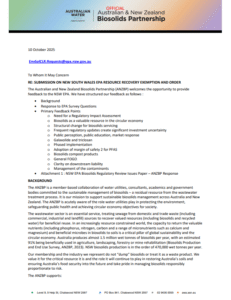ANZBP response to NSW EPA’s draft Resource Recovery Order and Exemption for Biosolids
ANZBP, supported by AWA, is pleased to share our response to the NSW EPA’s Draft Resource Recovery Order and Exemption for Biosolids. This collective submission represents the unified voice of ANZBP partners and was developed through member-exclusive discussions and a dedicated workshop with the NSW EPA.
Vice-Chair Position Announcement
The Australian and New Zealand Biosolids Partnership (ANZBP) is pleased to announce the appointment of Matt Wood and Beatrice Yong as our new Vice-Chairs. Both Matt and Beatrice bring a wealth of experience and passion for sustainable biosolids management.
Beatrice Yong

With over 14 years in the water industry, Beatrice Yong has managed metro south wastewater labs in Water Corporation, provided technical support to metro and regional wastewater operations and engaged with strategic planning through R&D projects. To optimise treatment processes for water, air, and solids streams, she is dedicated to continuous learning about emerging technologies, contaminants of concern, and social licensing—enabling informed assessment of opportunities and risks for water reuse and biosolids resource recovery in Western Australia.
Matt Wood

Matt Wood is a Senior Process Engineer at Sydney Water, supporting major water resource recovery facility upgrades across the network, including Malabar, St Mary’s, Quakers Hill, and Penrith. As Chair of the Resource Recovery Steering Group, he works closely with regulatory, operational, and strategy teams to advance Sydney Water’s circular economy and carbon zero goals, with biosolids as a key focus.
With a background in biosolids land application and contract management, Matt also co-chairs Sydney Water’s Production HSR Committee and brings a strong safety focus.
ANZBP 2024-2027 Strategic Plan
Dear ANZBP Members and Stakeholders,
The Australian and New Zealand Biosolids Partnership (ANZBP) is pleased to share the ANZBP 2024-27 Strategic Plan, which has been developed to guide the Australian & New Zealand Biosolids Partnership’s initiatives over the next three years.
This new plan outlines our commitment to sustainable biosolids management, focusing on fostering collaboration across the biosolids value chain, advocating for innovative technologies, and supporting policies that contribute to the circular economy.
Introducing the New ANZBP Advisory Committee
Dear ANZBP Members and Stakeholders,
We are proud to announce the refreshed ANZBP Advisory Committee.
The new advisory committee is comprised of 10 members, blending experience and fresh perspectives: ANZBP Advisory Committee
We look forward to the collective expertise and dedication of this committee as we continue to advance ANZBP’s vision and initiatives.
ANZBP Fact Sheet on Biosolids & PFAS
Dear ANZBP Members and Stakeholders,
The Australian and New Zealand Biosolids Partnership (ANZBP) is pleased to present its newly crafted ANZBP PFAS & Biosolids Factsheet. The intent of this factsheet is to provide interested parties with information about our understanding and management of per and polyfluoroalkylated substances (PFAS) in biosolids.
The factsheet explains:
- What biosolids are and why they are important?
- What are PFAS?
- Why we are interested in PFAS in biosolids?
- How PFAS are managed in biosolids and ANZBPs’ position on PFAS in biosolids?
ANZBP Submission to NSW EPA – Biosolids Regulatory Review (October 2023)
The ANZBP Advisory Committee has submitted a detailed response to the NSW Environment Protection Authority (EPA)’s Biosolids Regulatory Review Issues Paper and Technical Findings Report. This submission outlines the significant implications of the proposed changes to biosolids regulation and advocates for a flexible, risk-based, evidence-led approach that supports sustainable biosolids management across NSW.
Key themes include:
- Concerns over the proposed rigid contaminant thresholds and their impact on land application programs;
- The need for a systems approach that balances environmental risk with circular economy outcomes;
- Strong advocacy for source control measures for PFAS and other emerging contaminants;
- Recommendations for practical regulatory improvements including the adoption of HACCP-based frameworks.
This document is shared exclusively with ANZBP Partners for reference and further engagement. Please log in with your member account to download.
New ANZBP Membership Pricing Structure
Started in July 2024, ANZBP is introducing a new Partner Contribution Fee model. This initiative is designed to make membership more accessible for smaller utilities, consultants, students and end users. A discount will be available when partners sign and pay upfront 3 years.
Complimentary Memberships for End Users and Students
The Australian & New Zealand Biosolids Partnership (ANZBP) is thrilled to announce a new membership offering that gives Students and End Users (i.e. farmers) the opportunity to join ANZBP for FREE by application. This change in our membership structure is aimed at expanding our network and engaging key stakeholders from across the biosolids value chain.
As Students, to Apply: ANZBP Student Membership Application Form
As End Users, to Apply: ANZBP End User Membership Application Form
*Membership by application – send request to admin@biosolids.com.au
For further information on the benefits and products available by joining the ANZBP please download the flyer.
Australia and New Zealand Biosolids Production and End-use survey 2023
In 2010, the Australian & New Zealand Biosolids Partnership (ANZBP) commissioned a national survey to identify the main features of biosolids management across Australia and New Zealand. In 2010, 2013, 2015, 2017, 2019, 2021, and 2023 we took a snapshot of the sector, examining the following key parameters:
• Biosolids production;
• Biosolids end use;
• Biosolids stabilisation grade;
• Biosolids contamination grade; (added in 2013)
• Biosolids primary stabilisation process;
• Biosolids dewatering process.
In 2021 and 2023, additional data has been collected to both update the survey in line with current and predicted trends and to obtain data that is anticipated to be useful to ANZBP members and government departments. These data are:
• Biosolids secondary stabilisation processes;
• End-use management and branding;
• Stockpile volumes;
• Transportation of biosolids to end-use site;
• Emerging contaminant management;
• Renewable energy production.
The final reports of the survey are now available for ANZBP members on the Member site of the ANZBP website. If you are an employee of ANZBP partners and need access to ANZBP resources and data, feel free to reach out to ANZBP Program manager.
ANZBP YEAR IN REVIEW
We’re excited to share the ANZBP 2022-23 Year in Review Report
The report provides insight into all that we achieved, including our:
- Biosolids Production and End-Use Survey
- Quantitative Risk Assessment Biosolids Case Study
- Lunch & Learn sessions
- Coffee & Cake sessions
- Webinar series
- Ozwater presentation and Members Meeting
- Advocacy and Communication
Thank you for your support and assistance in making last year a successful one. We look forward to working with you to continue building on our strengths in the year ahead!
Melbourne Water Biosolids Case Study – Quantitative Risk Assessment
Following the presentation on Quantitative Risk Assessment from Daryl Stevens (PhD) (Atura), Philip Wilkie (Melbourne Water), Nick O’Connor (Ecos Environmental Consulting) in ANZBP September Biosolids Lunch&Learn Webinar.
The Australian & New Zealand Biosolids Partnership has released a Case Study report: Biosolids Case Study – Quantitative Risk Assessment.
The QRA was developed by Melbourne Water with international peer-review from the Imperial College London. The QRA analyses potential pathways of chemicals/contaminants found within wastewater from the wastewater treatment process through to the end-use of biosolids.
The QRA provides valuable data to Melbourne Water for biosolids land application.
Community Attitudes to Biosolids Survey – Public Report Released
The Australian & New Zealand Biosolids partnership, an industry program of the Australian Water Association, has released a public report based on a survey conducted by Newgate Research of over 1200 people in Australia and New Zealand.
Survey topics in the publicly available report include awareness and understanding of biosolids as a by-product of wastewater treatment, and the most acceptable uses for these by-products according to community sentiment. The survey also tested the effect of information about biosolids on community attitudes. The full report available to ANZBP program subscribers contains detailed results of this part of the survey.
Subscribers to the ANZBP program support industry-wide initiatives like the Community Attitudes to Biosolids Survey. For more information or to subscribe contact the ANZBP program manager.
COVID-19 and Biosolids
The ANZBP Chair and Committee have synthesised available research material to develop a factsheet on COVID-19 and biosolids.
Indications are that while the virus may be detectable in faeces in small quantities, if the virus was to arrive at a treatment plant in a viable state (which has not been demonstrated) it would be readily destroyed by the treatment methodologies already in place to manage other pathogens.
MEMBERS
Our members’ only site offers a rich and diverse array of research and support materials to partnership members, ranging from technical research on odour, carbon and chemical contaminants through to communication and media tools to support community engagement.
Our most recent publications include:
- 2020 Community Attitudes to Biosolids Survey
- 2020 Biosolids Production and Use 2009-2019 Data Consolidation Report
- Biosolids Production and Use data 2018-2019
- Assessment of Emergent Contaminants in Biosolids (Chemicals of Concern Report) 2017
Member access is available to all staff of our subscribing partners. Please check your eligibility here and contact us for access if you work for one of our partners.
PUBLIC
Our public resources are freely available to enable all stakeholders in biosolids production and use to gain more insight into the processes that create biosolids and ensure their safe use in our communities. These include:








